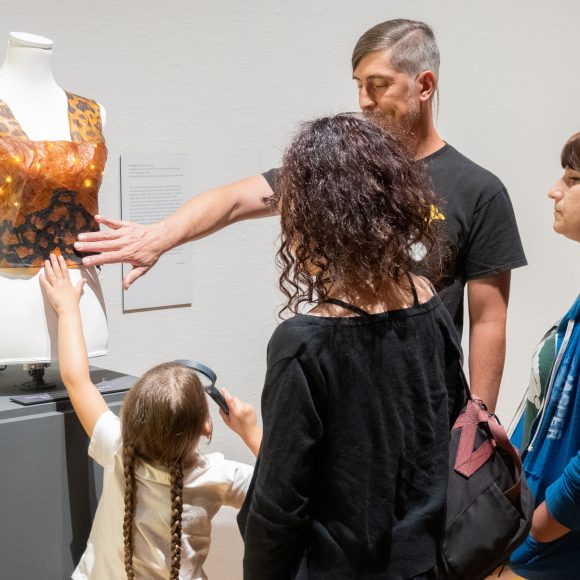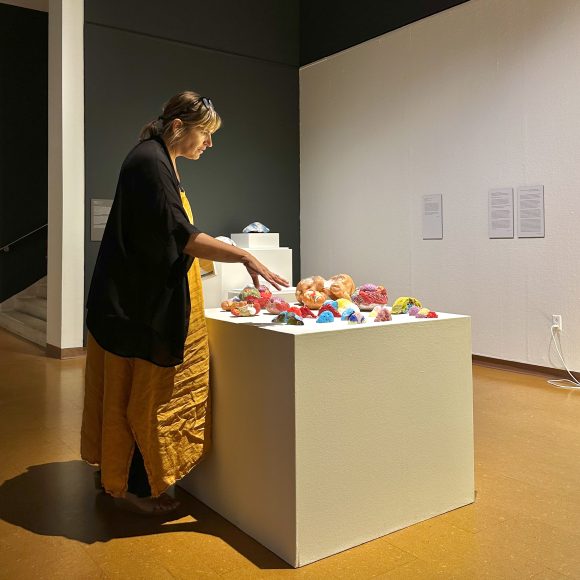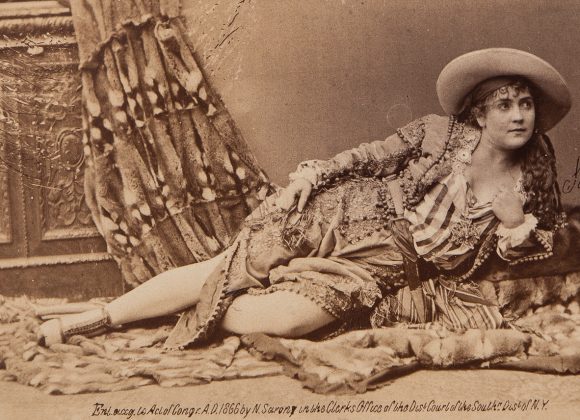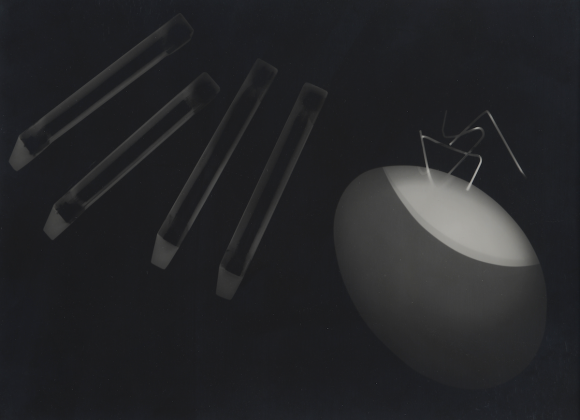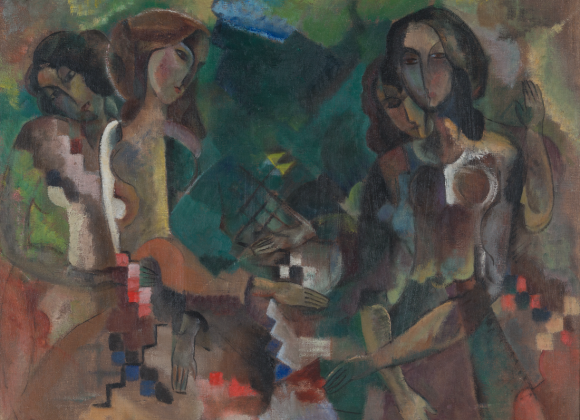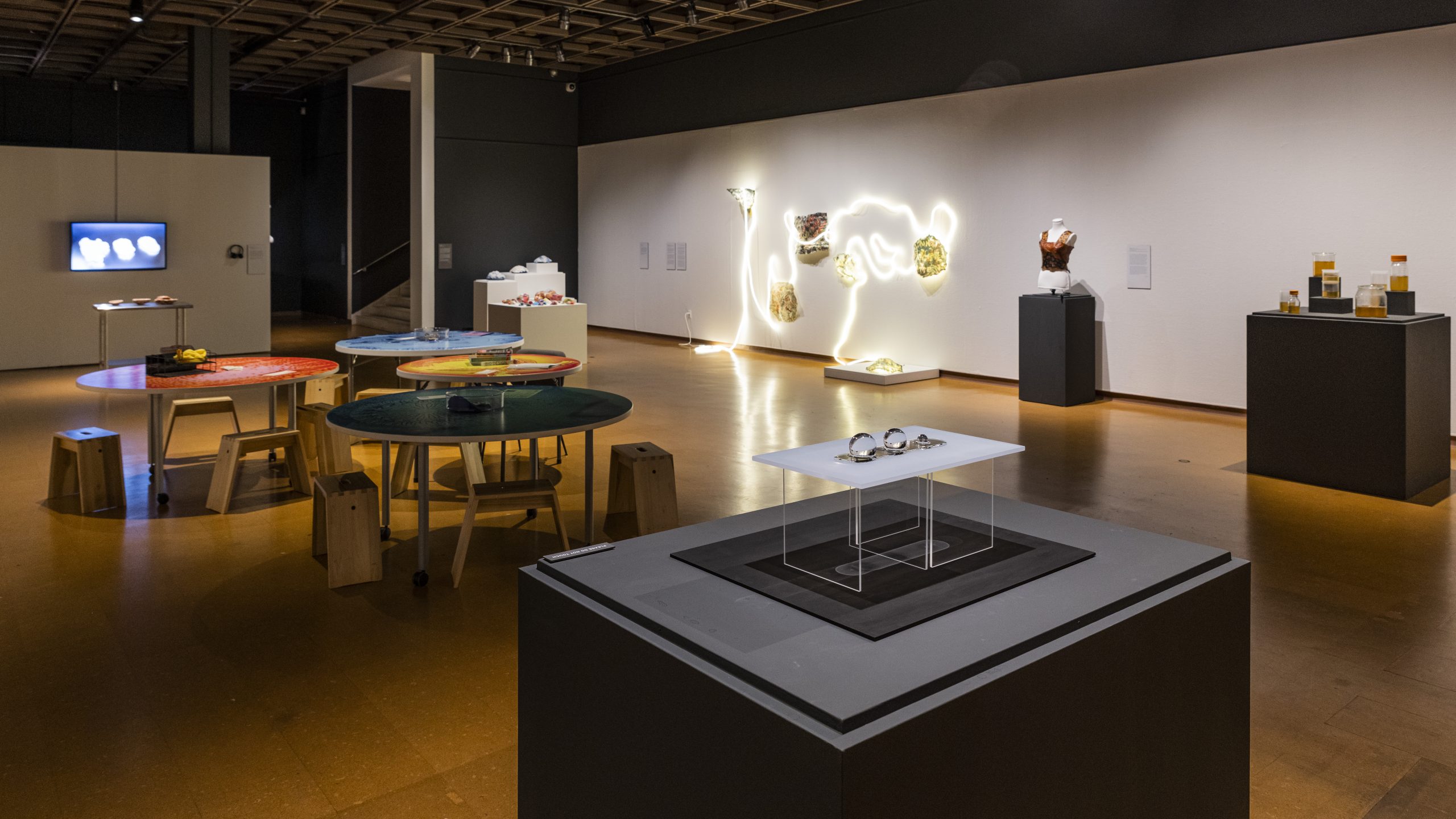
Hindsight Insight 5.0 is the final installment of the UNM Art Museum’s hybrid project and exhibition space devoted to complicating existing narratives about racism, colonialism, and gender stereotypes while de-centering curatorial authority and institutional voice.
Hindsight Insight 5.0 concludes the exhibition series by imagining the galleries as a laboratory, demonstrating how research and experimentation are put into action through projects at the intersection of art and science.
Created and curated by museum staff and collaborators, the exhibition features new artwork by five contemporary artists affiliated with the University of New Mexico and one object from the museum’s permanent collection: a nineteenth century album of microscopic photographs of the natural world.
The intention behind this ongoing experimental project is to honor and engage student and faculty perspectives, interests, and concerns to make art relevant and alive for the UNM Art Museum’s core audience. From Spring 2023 through Fall 2024, the museum staff has developed multiple iterations that engage the university community to generate critical dialogue that resists static presentation and fixed interpretations.”
-Mary Statzer, Curator of Prints & Photographs
Created & Curated By:
Fiona Bell (artist) is a Postdoctoral Fellow in the Department of Computer Science at the University of New Mexico. As a member of the Hand and Machine Lab, she designs, develops, and studies biomaterials that integrate with computational technologies to promote ecological sustainability. With a PhD in Creative Technology and Design from the University of Colorado Boulder and a BS in Mechanical Engineering from Santa Clara University in California, her research happens at the intersection of human-computer interaction, material science, and sustainable biodesign.
Bell has co-authored over 17 peer-reviewed journal articles and conference proceedings, and has received numerous juror awards and honors for presentations of her work. She has collaborated with industry and universities around the world and holds a patent with Mirela Alistar for Algany—a sustainable bioplastic made from marine algae. As an active member of the Association of Computing Machinery and the BiodesignChallenge, she helps promote sustainability in the design of new material technologies.
Kaitlin Bryson (artist) is a queer transdisciplinary ecological artist who holds a faculty position in Art & Ecology at the University of New Mexico and is the Field Coordinator for the Land Arts of the American West Program. Bryson has exhibited in the United States as well as Mexico, Ireland, and Nepal. Her artwork and activism have been featured in books and magazines such as In Search of Mycotopia: Citizen Science, Fungi Fanatics, and the Untapped Potential of Mushrooms by Doug Bierend (Chelsea Green Publishing, 2021) and Antennae: The Journal of Nature in Visual Culture. Her work has been supported by grants from the Lannan Foundation, the Andrew W. Mellon Foundation, and others.
Bryson earned her MFA in Art & Ecology from UNM where she studied both art and mycology with research emphasis on ecotoxicology. Her current practice is research-based and often collaborative. In 2019, Bryson co-founded The Submergence Collective focused on multidisciplinary projects that imagine collaborative, creative, hopeful, and ecologically connected futures for our human species and the rest of the living world. She has worked on multiple projects with Tewa Women United and Communities for Clean Water in New Mexico.
Rachel Cox (artist) has worked primarily in image-based media on two long-term personal projects, exploring the American funeral industry and the reproductive healthcare system. Cox holds an MFA in Photography from the University of New Mexico. She currently lives in Iowa City, IA, where she is Assistant Professor of Photography at The University of Iowa.
Cox’s photographs have been exhibited in museums and photo fairs in the US and abroad, including the Kemper Museum of Contemporary Art, Kansas City, MO; The Houston Center for Photography; The Belfast International Photography Festival; The Musée de l’Elysée, Lausanne, Switzerland; Museo Amparo, Pueblo, Mexico; and Photo London. Her work has been collected by more than a dozen museums, including The Museum of Fine Arts Houston, the Amon Carter Museum of Art in Fort Worth, and Pier 24 Photography in San Francisco. She also has an active editorial career, with publishing credits in GUP International Photography Magazine, Vice Magazine, The Huffington Post, The British Journal of Photograph, The Guardian, and TIME.
Susan Hyde Holmes (graphic design) earned a BFA in design from the University of Kansas, where she began her museum design career at the Spencer Museum of Art in the publications department. After moving to Santa Fe in 1994, Holmes began her tenure as exhibition graphic designer for the New Mexico Department of Cultural Affairs, serving the Museum of International Folk Art, Museum of Indian Arts & Culture, Palace of the Governors, New Mexico Museum of Art, and State Historic Sites. Additionally, Holmes was part of the team that publishes the Department’s El Palacio, the oldest museum magazine of its kind. Holmes is a performing musician (bass and guitar) as well, collaborating with local and national touring artists.
Steven Hurley (exhibition preparation and installation) assists with exhibition planning, matting and framing, scheduling, and execution of exhibitions. Hurley began his career in the arts at CAFE gallery in Albuquerque in 1994 and has since worked in the arts in various positions. Hurley began working at UNM Art Museum in 2005 as Curatorial Assistant, then Preparator, and is currently Coordinator of Exhibitions. He earned a BA in Liberal Arts at The Evergreen State College, Olympia, Washington.
Breanna Kappel (exhibition design and construction) is an educator, science communicator, and undergraduate student at the University of New Mexico. Their work with the UNM Art Museum on this exhibition fulfills a practicum in Museum Studies. For the past three years, Kappel has worked at UNM’s Museum of Southwestern Biology, leading outreach initiatives and bringing the public into an otherwise closed natural history collection. Kappel is inspired by the power of objects as catalysts for learning, storytelling, and connecting. Their critical study of the long history of collections-building and exhibitions is in pursuit of a better and more equitable future for museums and similar institutions. Kappel will graduate in May 2025 with a BA in Liberal Arts in Science Communication and Museum Studies.
Joseph McKee (student engagement, programs, and exhibit technology) is a freelance graphic designer, artist, and art historian. Their research explores the intersections of emerging technologies, queer identity, cyberspace, and digital colonialism. They hold a BA in Art History from the University of New Mexico. Most recently, McKee was a reviewer and panelist for the Association of Academic Museums and Galleries Conference (AAMG) and a reviewer for the 29th International Symposium on Electronic Arts (ISEA 2024).
McKee is the Coordinator of Student Engagement & Technology at UNM Art Museum. In this position they oversee the museum’s events, programs, and educational content. They are editor of Here to Inspire: the UNM Art Museum Journal, lead the museum’s Student Advisory Council (SAC), and assist in web design and marketing.
Amy Pilling (artist) is an artist and museum educator at the New Mexico Museum of Natural History and Science and co-coordinator of the University of New Mexico’s Bio Art & Design Challenge team.
Pilling received her BA from Scripps College in Claremont, California, where she studied German, Russian, and Holocaust Studies. She also studied ceramics at Pitzer College in Claremont, film at the Anthropology Film Center in Santa Fe, and studio art at Santa Fe Community College and UNM.
Pilling began exploring bio-art and sci-art in 2015. She collaborated with artist and educator Stephanie Rothenberg on The Myco-Planning Network, a citizen science art project, working with collective organisms such as fungal mycelium and slime mold to address hunger and food equity in New Mexico. She received a Fulcrum Fund Grant to create Life Arts Laboratory, a mobile bio-art laboratory for artists, citizen scientists, and educators. In 2022, she created Space Bears, an installation and educational experience introducing the wonders of the micro-world and tardigrades to children in Northern New Mexico. Her collaborators for Space Bears include STEMarts Lab, PneuHaus, STEAM NM and UNM College of Fine Arts.
Andrea Polli (artist and exhibition content) is a Professor in the College of Fine Arts and School of Engineering at the University of New Mexico. She holds the Mesa Del Sol Endowed Chair of Digital Media and directs the Social Media Workgroup, a lab at UNM’s Center for Advanced Research Computing. Polli created the first Bio Art and Design courses at UNM and has been collaboratively developing the curriculum with other faculty and across disciplines for nearly 10 years.
Polli is an environmental artist whose interdisciplinary research has been presented as public artworks, media installations, community projects, performances, broadcasts, mobile and geolocative media, publications, exhibitions and public events. She creates artworks designed to raise awareness of environmental issues and often expresses data obtained through her collaborations with scientists and engineers. Polli holds an MFA in Time Arts from the School of the Art Institute of Chicago and a PhD in practice-led research from the University of Plymouth in the UK.
Polli has had over 20 solo exhibitions and more than 125 group exhibitions in the US and abroad. Since 2009, she has given over 200 keynote addresses and professional presentations of her art and research. She has received major support from The National Endowment for the Arts, The National Science Foundation, The Fulbright Commission, and others. She has published two books—Far Field: Digital Culture, Climate Change and the Poles (Intellect Press, 2012) and Hack the Grid (Carnegie Museum of Art, 2018)—as well as numerous book chapters, articles, and essays.
Mary Statzer (exhibition concept, layout, and written texts) is a curator and educator who is most at home in museums. Statzer grew up in Illinois and moved to the southwest where she has lived and worked in Arizona and New Mexico. Statzer trained as an artist and art historian, earning a BFA in printmaking and drawing from Illinois State University, an MFA in printmaking from Arizona State University, and PhD in the theory and history of art from University of Arizona. Photography and print are Statzer’s specialties. She published a book titled The Photographic Object 1970 (University of California Press, 2016). Statzer is currently Curator of Prints and Photographs at the UNM Art Museum, where she has organized nearly twenty exhibitions in all mediums of art over the past seven years.
From the Collection
Unidentified photographer, Microphotographs Presented to the Royal Institute of Chemistry by Henry Droop Richmond, c. 1877-1883. Bound volume with 43 pages of albumen print photographs. Transferred from the University of New Mexico Fine Arts and Design Library.
Microphotographs Presented to the Royal Institute of Chemistry by Henry Droop Richmond was included in a study room visit for students in Andrea Polli’s spring 2023 class. The photographs depict various types of algae, micro-organisms, molds, fungi, plant fibers, vegetable tissues, animal tissues, starch granules, blood corpuscles, parasites, and crystals, all at 35x to 1100x magnification. Visually compelling and open to interpretation, it is the anchor and catalyst for this exhibition.
The Main Gallery features a group exhibition by artists Fiona Bell, Kaitlin Bryson, Amy Pilling, and Andrea Polli, all of whom engage with biomaterials and sustainable practices. Material exploration is key to Hindsight Insight 5.0. Bioplastics made from agar and prickly pear cactus, glass, water, clay, and clay-dough made from eggs, leaves, and orange peel take on an array of forms. Natural organisms like spirulina algae and kombucha SCOBY are also on view so that visitors may contemplate their inherent natural beauty and potential to feed, nourish, and inspire us.
Throughout the semester, Bryson will use the museum as a classroom for the course Art & Ecology/Material Practice, with students contributing their own artwork to the exhibition.

In the adjacent Van Deren Coke Gallery, Notes on Care, a solo exhibition by UNM alum Rachel Cox, further explores the intersection of art and science. Featuring photographs from the series Portrait of a Woman, this highly personal body of work chronicles Cox’s experience accessing fertility treatment to start a family.
The exhibition depicts the process of in vitro fertilization, a medical procedure that is rarely observed by the public or depicted in the media. By making her own body and treatment visible, Cox’s photographs serve as sources of information and comfort.
Readings and Resources
Below is a collection of readings, articles, videos, and online resources that expand on the themes of Hindsight Insight 5.0. Items in this list were selected by exhibition collaborators and museum staff.
- Growing Semi-Living Sculptures: The Tissue Culture Art Project by Oron Catts, Ionat Zurr – PDF
- How do bodies, commodities, and the digital intersect? by Rose Nestler – Art21
- BioArt: Is It Art? Is It Science? Is It the Future? By Steph Walden – Mashable
- Treachery of Images by Ruby Justice Thelot – outland.art
- The Work of Art in the Age of Mechanical Reproduction by William Benjamin – PDF
- Symbiotopics by BioArt Laboratories – Spotify
- Biofriction Radio – Biofriction
- Abstract: The Art of Design, Neri Oxman: Bio-Architecture, Season 2, Episode 2
- BioArt – Art from the Laboratory – YouTube
- Smelfies, and other experiments in synthetic biology by Ani Liu – TED
- Strange Culture by Steve Kurtz Critical Art Ensemble – YouTube
- Biomodd: A Living Computer by Angelo Vermeulen – YouTube
- Microbial Videogames by Ingmar Riedel-Kruse – YouTube
- Designing With Biology by Suzanne Lee – YouTube
- We’re covered in germs. Let’s design for that. By Jessica Green – TED
- Treachery of Images – Ruby Justice Thelot – YouTube
- WhiteFeather Hunter – Website
- Adam Brown – Website
- Carolyn Angleton – Website
- Andy Gracie – Website
- Maria Castellanos – Website
- Brandi Lee Cooper – Website
- Ani Liu – Website
- Amy Karle – Website
- Kuai Shen – Website
- Ai Hasegawa – Website
- Agi Haines – Website
- Neri Oxman – Website
- Anicka Yi – Website
- Tiare Ribeaux – Website
- Mary Maggic – Website
- Kathy High – Website
- Alexandra Daisy Ginsberg – Website
- Philip Beesley – Website
- Sandor Katz – Website
- Mitchell Joachim – Website
- Anicka Yi – Wikipedia
- Biofriction – Website
- BioBabes – Website
- Incubator Art Lab – Website
- Materiability – Website
- Living Matter Lab – Website
- Materials Experience Lab – Website
- Bioart Society – Website
- Hub for Biotechnology in the Built Environment – Website
- Faber Futures – Website
- Hackteria – Website
- Materiom – Website
Collaboration in process…
Hindsight Insight 5.0 is an ongoing process. Watch this space for new articles, upcoming events, and invitations to engage with the exhibition.
UPCOMING EVENTS:
Click here to view all upcoming events supporting Hindsight Insight 5.0.
LEARN MORE:
Looking Back
Hindsight Insight 5.0 concludes the multiyear exhibition series that began in the Spring of 2023. Through this initiative, UNMAM invited the university community and other collaborators to actively participate in the development, presentation, and interpretation of each exhibition. Review previous iterations of the series here:

